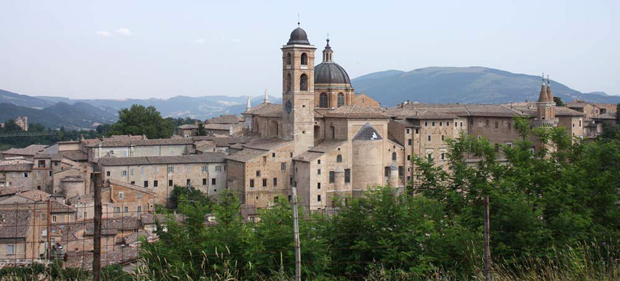Strict building and renovation codes maintain Urbino’s historic heritage, but for some business and home owners, they carry a weighty burden.
URBINO, Italy — The city tops a hill in the Apennine Mountains of central Italy. It emerged as an experimental center for Renaissance architecture in the middle of the 15th century.
Yet it still occupies a special place today as a model of town planning and construction of the period. Though sometimes preserving that legacy can exact a toll on the residents.
[pullquote]Urbino is unique, it’s unique in all Italy. It has been able to preserve its urban structure almost intact.[/pullquote]
“Urbino is unique, it’s unique in all Italy,” said Alessandro Marchi, chief superintendent of art history of the region, speaking through an interpreter. “It has been able to preserve its urban structure almost intact.”
Its buildings and city planning made it the “Ideal City” during the Renaissance, with architects visiting to study its perfection. Today the town’s population of 15,000 is outnumbered by 20,000 college students from the University of Urbino. But despite the changing of time, Urbino remains a city to emulate.
“Urbino needs to be preserved because it has been kept almost intact, like few other cities in Italy,” Marchi said, leaning forward with excitement, the creaking of his antique leather chair amplified in the high ceilinged room of the Dual Palacio. “In Urbino the old buildings have been kept, even the setting of the houses, the streets, the squares…all of it.”
Described as the apex of Renaissance art and architecture, Urbino was added to UNESCO’s World Heritage list in 1998.
“These are not only towns, cultural assets, or landscapes,” said Claudio Ricci, president of the Association of Italian World Heritage Properties of UNESCO, “but sites full of atmosphere that comes from the ability to build of stone, brick that captures history and life experiences.”
“Urbino is unique because of how it’s made and how it’s structured,” Marchi said. “There isn’t this [architectural] homogeneity in any Italian cites, even those of the Renaissance.” He contrasted it to Florence’s isolated Renaissance buildings, no longer in a homogenous setting, but often swamped by Florence’s modernity.
[pullquote]If our buildings were to be surrounded by skyscrapers or industries, they wouldn’t have the same value and meaning.[/pullquote]
“If our buildings were to be surrounded by skyscrapers or industries, they wouldn’t have the same value and meaning,” said Luana Alessandrini, an architect in Urbino’s office of city and environmental planning. “Urbino is Urbino because it’s what it is: Its walled town, its buffer zone, its context.”
Her office manages the public buildings and city infrastructure, commercial buildings, the authorization of activities, tourism, and cultural institutions. It is responsible for keeping Urbino in line with many complex codes and regulations to preserve its past.
For instance, in order to restore and repair a house, the owner must first look up the file held by the city for every property, indicating specific architectural and construction requirements that must be followed in accordance with UNESCO. The files define everything from the degrees of the archway to the arrangement of tiles on the roof.
“The file is really detailed and strict,” Alessandrini said. “The intersections between bricks have to be made in a certain way; wall painting, too. For example, you can’t just use cement as you do in new types of buildings; you have to use the old method.”
Expensive, handmade bricks must be used within the center of Urbino to conform to its appearance. Even the grout between bricks is specified. The city can halt any project if the owners do not follow the UNESCO requirements.
As much as some citizens applaud the control and preservation, others chafe under the restrictions.
“I feel less than positive. I am limited in this area,” said Bar del Teatro owner Riccardo Marchionni of his bar on Via Garibaldi. “With more space we could do other things, it is a very small space.”
The bar is particularly restricted because it’s housed in the classic and highly protected Teatro Sanzio. It’s shadowed by the facade of the Palace to its left, while it has an undisturbed panorama of the rolling hills to its right. While Bar del Teatro’s interior has been renovated, expansion of the exterior beyond the classic brick façade of the theatre would violate preservation codes.
Yet it’s a two-edged sword for the café, because while the regulations limit its expansion, they also preserve its iconic, unobstructed view of the surrounding valleys and mountains that makes it unique.
Yet for most, the limitations are worth it. The Renaissance city remains unique in an age of modernization, University of Urbino design student Filippo Pinreno said.
“Urbino is different because of the strange relationship between people and place,” Pinreno said. “We are in a Middle Ages town, yet it is a Renaissance town full of young people, and young people ironically are the citizens of that ancient place.”
Multimedia
